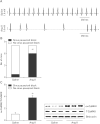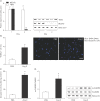Protective effects of kaempferol against cardiac sinus node dysfunction via CaMKII deoxidization
- PMID: 26770873
- PMCID: PMC4701696
- DOI: 10.5115/acb.2015.48.4.235
Protective effects of kaempferol against cardiac sinus node dysfunction via CaMKII deoxidization
Abstract
Kaempferol exerts cardioprotective actions through incompletely understood mechanisms. This study investigated the molecular mechanisms underlying the cardioprotective effects of kaempferol in sinus node dysfunction (SND) heart. Here, we demonstrate that angiotensin II (Ang II) infusion causes SND through oxidized calmodulin kinase II (CaMKII). In contrast to this, kaempferol protects sinus node against Ang II-induced SND. Ang II evoked apoptosis with caspase-3 activation in sinus nodal cells. However, kaempferol lowered the CaMKII oxidization and the sinus nodal cell death. To block the CaMKII oxidization, gene of p47phox, a cytosolic subunit of NADPH oxidase, was deleted using Cas9 KO plasmid. In the absence of p47phox, sinus nodal cells were highly resistance to Ang II-induced apoptosis, suggesting that oxidized-CaMKII contributed to sinus nodal cell death. In Langendorff heart from Ang II infused mice, kaempferol preserved normal impulse formation at right atrium. These data suggested that kaempferol protects sinus node via inhibition of CaMKII oxidization and may be useful for preventing SND in high risk patients.
Keywords: Angiotensin II; CaMKII; Kaempferol; Sinus node dysfunction.
Figures






Similar articles
-
Insulin sensitization causes accelerated sinus nodal dysfunction through autophagic dysregulation in hypertensive mice.Transl Clin Pharmacol. 2021 Jun;29(2):92-106. doi: 10.12793/tcp.2021.29.e9. Epub 2021 Jun 22. Transl Clin Pharmacol. 2021. PMID: 34235122 Free PMC article.
-
Oxidized CaMKII causes cardiac sinus node dysfunction in mice.J Clin Invest. 2011 Aug;121(8):3277-88. doi: 10.1172/JCI57833. Epub 2011 Jul 25. J Clin Invest. 2011. PMID: 21785215 Free PMC article.
-
Angiotensin II-induced oxidative stress resets the Ca2+ dependence of Ca2+-calmodulin protein kinase II and promotes a death pathway conserved across different species.Circ Res. 2009 Dec 4;105(12):1204-12. doi: 10.1161/CIRCRESAHA.109.204172. Epub 2009 Oct 22. Circ Res. 2009. PMID: 19850941
-
Sinus Node Dysfunction and Atrial Fibrillation: A Reversible Phenomenon?Pacing Clin Electrophysiol. 2017 Apr;40(4):442-450. doi: 10.1111/pace.13030. Epub 2017 Mar 8. Pacing Clin Electrophysiol. 2017. PMID: 28155995 Review.
-
Genetics and Sinus Node Dysfunction.J Atr Fibrillation. 2009 Apr 1;1(6):151. doi: 10.4022/jafib.151. eCollection 2009 Apr-May. J Atr Fibrillation. 2009. PMID: 28496616 Free PMC article. Review. No abstract available.
Cited by
-
Kaempferol inhibits proliferation, migration, and invasion of liver cancer HepG2 cells by down-regulation of microRNA-21.Int J Immunopathol Pharmacol. 2018 Mar-Dec;32:2058738418814341. doi: 10.1177/2058738418814341. Int J Immunopathol Pharmacol. 2018. Retraction in: Int J Immunopathol Pharmacol. 2021 Jan-Dec;35:20587384211040394. doi: 10.1177/20587384211040394. PMID: 30477356 Free PMC article. Retracted.
-
Navigating Calcium and Reactive Oxygen Species by Natural Flavones for the Treatment of Heart Failure.Front Pharmacol. 2021 Nov 9;12:718496. doi: 10.3389/fphar.2021.718496. eCollection 2021. Front Pharmacol. 2021. PMID: 34858167 Free PMC article. Review.
-
Insulin sensitization causes accelerated sinus nodal dysfunction through autophagic dysregulation in hypertensive mice.Transl Clin Pharmacol. 2021 Jun;29(2):92-106. doi: 10.12793/tcp.2021.29.e9. Epub 2021 Jun 22. Transl Clin Pharmacol. 2021. PMID: 34235122 Free PMC article.
-
Cardioprotective Properties of Kaempferol: A Review.Plants (Basel). 2023 May 24;12(11):2096. doi: 10.3390/plants12112096. Plants (Basel). 2023. PMID: 37299076 Free PMC article. Review.
-
Kaempferol promotes bone formation in part via the mTOR signaling pathway.Mol Med Rep. 2019 Dec;20(6):5197-5207. doi: 10.3892/mmr.2019.10747. Epub 2019 Oct 16. Mol Med Rep. 2019. PMID: 31638215 Free PMC article.
References
-
- Yang LZ, Kockskämper J, Khan S, Suarez J, Walther S, Doleschal B, Unterer G, Khafaga M, Mächler H, Heinzel FR, Dillmann WH, Pieske B, Spiess J. cAMP- and Ca(2)(+) /calmodulin-dependent protein kinases mediate inotropic, lusitropic and arrhythmogenic effects of urocortin 2 in mouse ventricular myocytes. Br J Pharmacol. 2011;162:544–556. - PMC - PubMed
-
- Wang Y, Cui H, Wang W, Zhao B, Lai J. The region-specific activation of Ca2+/calmodulin dependent protein kinase II and extracellular signal-regulated kinases in hippocampus following chronic alcohol exposure. Brain Res Bull. 2012;89:191–196. - PubMed
LinkOut - more resources
Full Text Sources
Other Literature Sources
Research Materials
Miscellaneous
